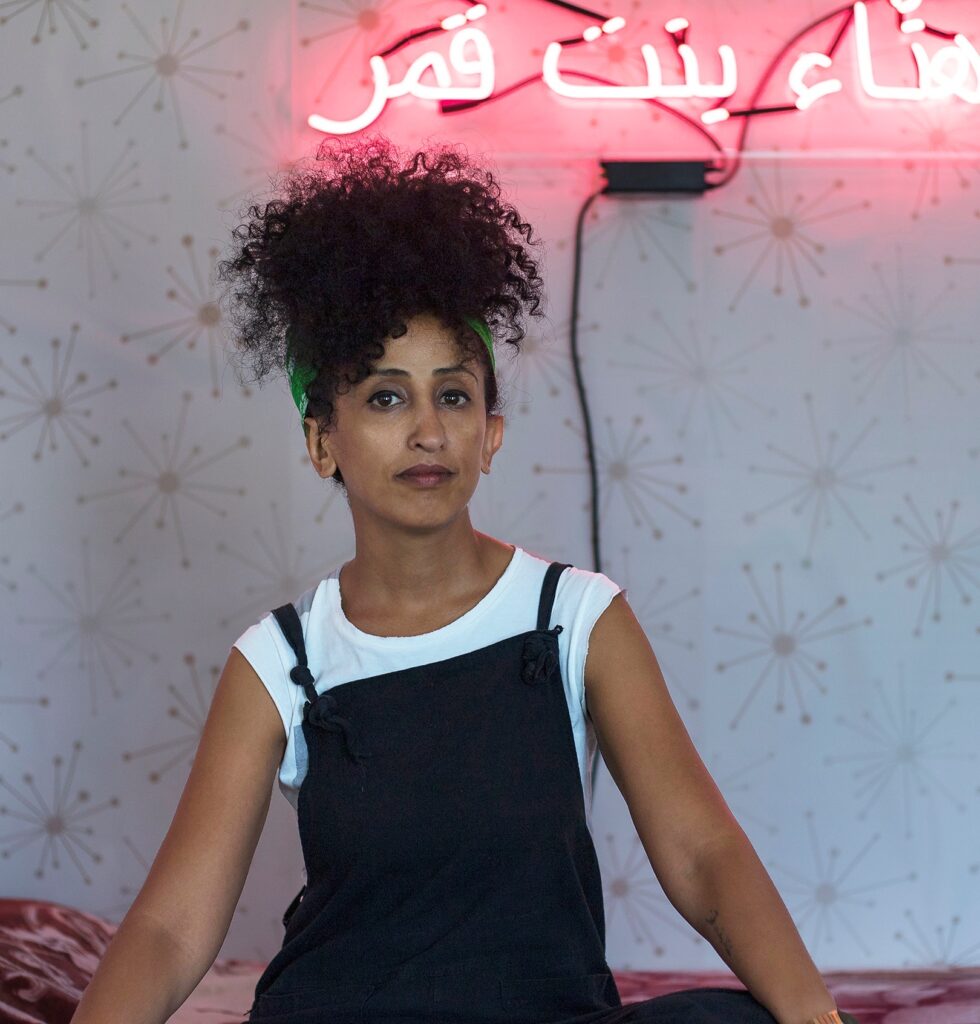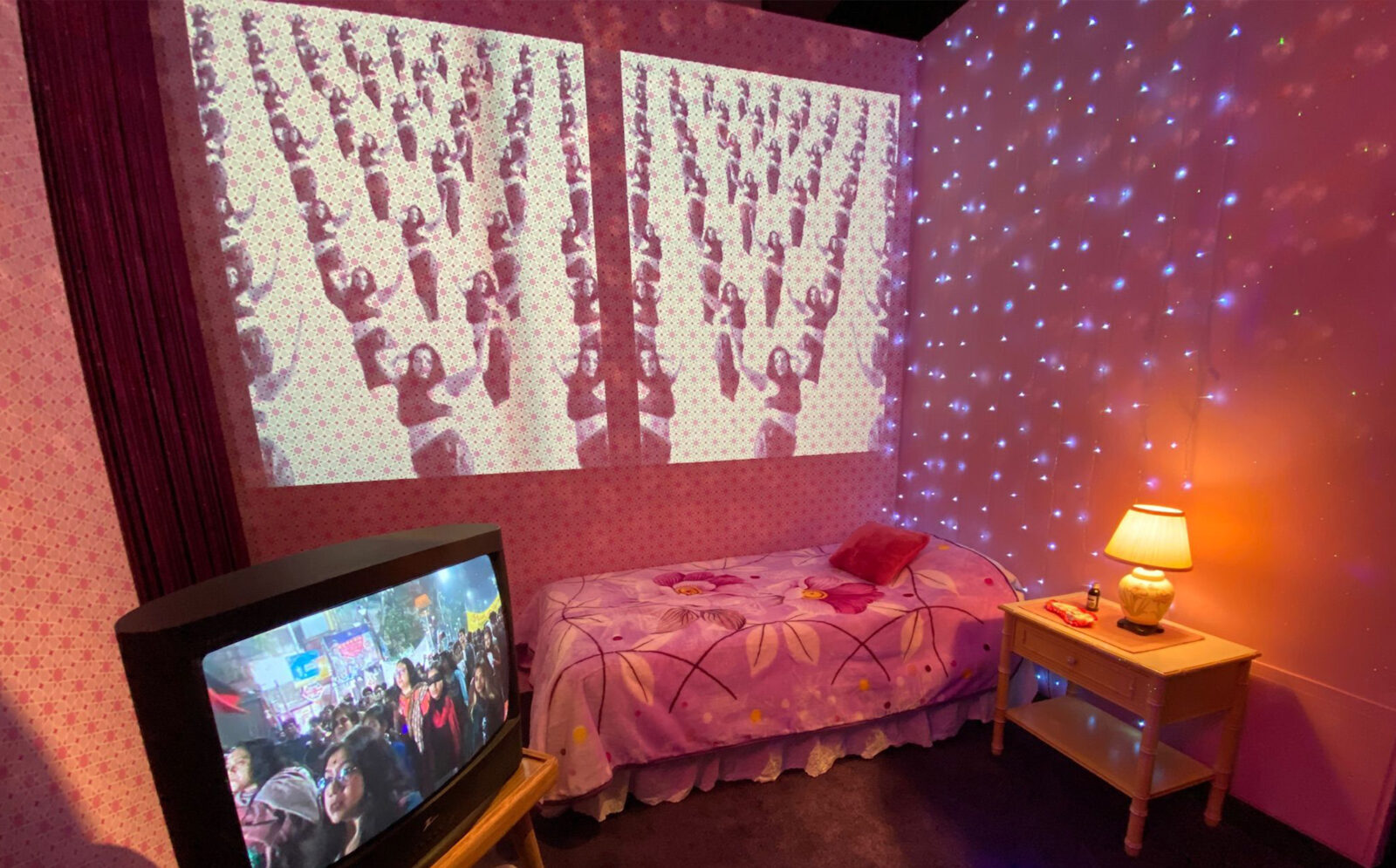Our bedrooms would have seen more of us over the past year than ever before, due to the stay-at-home lifestyle brought on by the pandemic. Whether we are meditating, working or studying, our bedrooms have become a hyper-familiar living space to each of us. Interestingly, the multidisciplinary Yemeni-American artist, Yasmine Nasser Diaz created an installation to draw attention to the power and personality behind our bedrooms. Her recent installation For Your Eyes Only presents the setting of a girl’s bedroom in the form of a window display. The exhibition is available to preview online and in person at The University of Michigan’s Institute for Humanities, where you can see it from the sidewalk on Thayer Street. Through Yasmine’s set design, she exposes what would otherwise be a personal space to evoke a discourse between private and public environments merging together, as we often see on social media. A bedroom, which would typically be used as a space to sleep in, has now become the backdrop for many people’s Instagram posts or TikTok dance videos. In our recent interview with Yasmine, she shares more about what inspired her to produce this exhibition for us to see.

How did your engagement with art begin?
I always drew a lot as a kid, but it was during high school when art became something I took more seriously. I first fell in love with oil painting and although I did not attend art school, I continued to paint on my own. But it wasn’t until many years later, when I was in my thirties, that I felt ready to address the topics my work focuses on now; gender, religion, third-culture identity, and my complicated personal history.
As a multidisciplinary artist, how do you engage with different mediums to represent your interests as an artist?
I was still oil painting when I was ready to shift gears and finally make work that was more personal and relevant to my background, but the usual process and medium didn’t feel right for some reason. I was struggling with how to share some very vulnerable details for the first time so I decided to use collage. So, I began experimenting with it and was reminded of how playful and liberating a medium it can be. I especially loved the parallels between what collage inherently is and what it means to hold third-culture identity. Since then, the decisions to switch from one medium to the next have been very naturally driven by the content of the work. I love how installation allows me to construct intimate spaces that can feel familiar to many while holding details that tell very unique stories.
What is your take on the boundaries between public vs. private environments colliding on social media platforms?
I’m continually fascinated by this grey area. Instagram, TikTok, etc., did not exist when I was growing up, so I feel hyper aware of how those platforms could have been helpful for people like myself who struggled with issues specific to our particular communities (in my case, Yemeni-American) but had no way of finding each other. For example, in my family it was considered taboo to talk about religion critically or to express any doubts. I think having access to this kind of public space to say or share things that one may feel inhibited from doing in their day-to-day life can be extremely liberating and may help to find a supportive community. Of course, it is also a bit of a double-edged sword. There are many things to be wary of when sharing personal content and exposing oneself to the public, it’s definitely an arena to enter with caution.
Can you tell me about your latest installation, For Your Eyes Only?
For Your Eyes Only is the fourth iteration of my bedroom installation series which began in 2018. It started as directly autobiographical and has gradually shifted to being inspired and informed by the lives and stories of other Yemeni or Southwest Asian/North African (SWANA) women and non-binary people. In the past, I always designed these installations to be immersive and interactive. I wanted people to touch things, to spray and smell the perfumes, to listen to the cassette tapes. Because of Covid of course, that wasn’t possible. Visitors could not enter the space so the installation was designed to be viewable only via the window. This made me think about how that experience paralleled with the ways in which intimate content is shared and experienced on social media.
How did you tackle the challenge of creating an accessible installation for your audience?
An audio track of minimalist house music composed by Beirut-based Carol Abi Ghanem, can be heard from the street as you approach the building. Projected into the space is a montage of videos shared by female-identifying and non-binary persons of SWANA* background dancing solo in their rooms, all used with permission. Simultaneously playing on a television set is a reel of political figures and women-led protest movements from the SWANA region. I was thinking about the thread between these actions that all involve a level of risk by engaging our bodies in ways that demonstrate an assertion of autonomy.
What artists and art movements inspire your practice?
I’m equally inspired by films, books, other visual artists, and the personal stories that have been shared with me. There have been wonderful films from the last decade or so that centre young women’s coming of age experiences. Persepolis, Mustang, Diary of a Teenage Girl, In Between, are the kind of nuanced narrative films that simply did not exist when I was a teen.
Guadalupe Rosales, Pepon Osorio, and Genevieve Gaignard are all LA-based artists who have used installation to recreate domestic spaces in a way that I found to be especially impactful and that intersect art and archiving in a beautiful and poignant way. Rania Mattar’s photo series, A Girl and Her Room, documents teenage girls from across the globe pictured in their bedrooms. It made me think about how using the same framework repeatedly highlights both the areas of commonality and uniqueness of these spaces and individuals.
How has COVID-19 impacted your art and in which ways have you overcome the obstacles that you encountered?
I was in Michigan installing soft powers, my first solo museum show in March of 2020 when everything shut down. All of the work is still there, but the show has never been physically accessible to the public. (The museum tentatively plans to reopen its doors this fall.) Shortly after I returned to LA, I started working on a short 3-minute video about the work and process. It’s become an invaluable tool and made it possible for more people to see the show than otherwise would have in person.
This time has also impacted how I think about collaborating. Even though we already had the capability to connect with people in other countries, there was something about this time that made me less hesitant to reach out to Carol, the DJ in Beirut I mentioned earlier. It suddenly felt like much less of an obstacle to work together remotely.
Can you give me an insight into any future works that we can expect to see from you?
I’m working on some other collaborative projects that I can’t yet talk about as well as plans to bring For Your Eyes Only to other locations. Stay tuned!
To keep updated about Yasmine’s practice and installation follow her on Instagram @yasmine.diaz.


